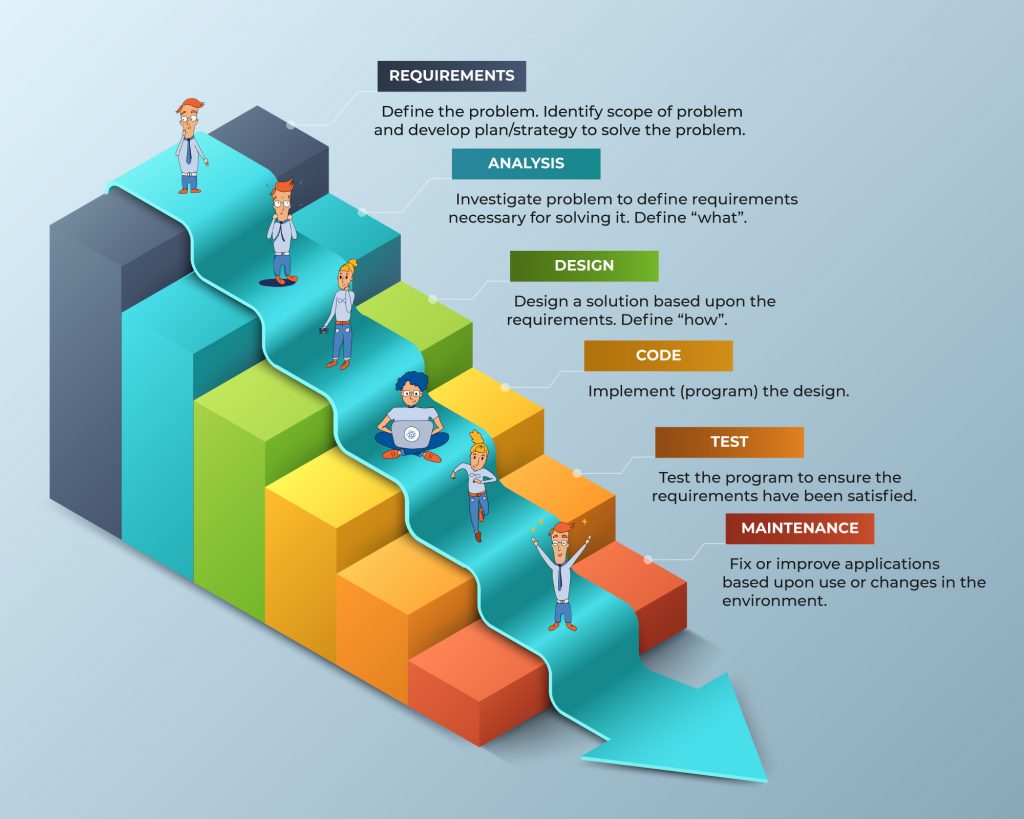In this unit, we are learning about Project Management, so we are going to talk about the Waterfall approach. This tool is one of the options you can pick to get along with the projects.
As a rather traditional approach, the Waterfall approach is a rather strict and chronological Project Management procedure that works based on fixed dates, requirements, and outcomes. It is a method developed to work in teams, however, with Waterfall, teams aren’t required to be in constant communication and can work independently. The process consists out of five phases, that are:
- Requirements
- Design
- Implementation
- Verification or Testing
- Development and Maintenance

Those phases and their order are complied with strictly, and one phase doesn’t begin until the previous one is finished; meaning each phase must be fully completed before the next one starts. Thus, the Waterfall method is considered a linear Project Management method. Any changes that might want to be conducted need to be carried out in the early development stages. In the following, each phase of the Waterfall method will be examined in more detail:
I. Requirements
Since the waterfall methodology is based on the belief that all project requirements can be gathered and understood upfront and in the very beginning during the planning phase, our first step is collecting these requirements that are necessary for the project to be considered successful.
The first step is basically the responsibility of the project manager, who – being the only person fully aware of the expectations of the project sponsor – sets the necessary requirements and makes sure that the participants also get a detailed understanding of them.
In the case of the Waterfall Methodology, the project manager creates a single document including the written requirements and the description of each stage of the project. This report consists of the costs, assumptions, risks, dependencies, success metrics and timelines for completion. Generally, these metrics include both quantitative and qualitative ones.
II. Design
During the second phase, the software developers will take actions by designing a technical solution for the given problem. They need to follow the requirements defined in advance. In the second step, the developers include scenarios, layouts and data models. However, this phase can be further divided into two additional steps. The first one is the logical design, the center of which is the purpose and the scope of the project. In the next step they transform all the above mentioned into a physical design.
III. Implementation
In the third step comes the technical implementation. This one is considered the shortest phase since the design and the research has already been done. The programmers code the application, then carry out some testing and eventually, the implementation. However, it is important to note that during or even after this phase, if a significant change is required, this probably means going back to the design phase. This example truly clarifies why the Waterfall Method is considered iterative.
IV. Verification or testing
Despite the fact this step is self-explanatory, it is essential and could lead to fatal errors if missing. The testing team ensures that the final product does not contain any mistakes and fulfills the requirements. Good user experience is also a targeted and important factor during this phase. The team creates different test cases, in which the product manager supplies design documents, personas, user case scenarios.
V.Deployment and maintenance
In the last phase the software has already been deployed in the market or released to customers and the maintenance phase begins. Defects are generally reported by the users and should be corrected, while simultaneously releasing updates and new versions.
Who uses it?
- Don’t have ambiguous requirements.
- Offer a clear picture of how things will proceed from the outset.
- Have clients who seem unlikely to change the scope of the project once it is underway.
- At the beginning of the project, there are clearly defined processes, where cost, design, and time requirements are known upfront.
In the upcoming section, you will find a brief summary on some of the most important pros and cons that need to be considered when you want to decide whether to work with the Waterfall approach.
Pros:
– Since the requirements are clearly laid out from the beginning, a very structured approach is possible (progress is easy to measure).
– The structured approach of the method helps to measure progress according to project objectives which were defined beforehand.
– The total cost of the project can be estimated precisely as well as the timeline.
– Developers who join the project can easily catch up, since all necessary information will be available in the requirements document.
Cons:
– The waterfall method is not necessarily the fastest method, because it follows a chronological approach.
– Clients / Customers are not involved in the design and implementation stages.
– As the method follows a chronological approach, if one phase of the project is delayed the whole project will be delayed.
In conclusion, it can be said that the Waterfall approach is a traditional method that has proven to be successful in the past, mainly due to its simplicity. However, in order to implement it, its disadvantages, first and foremost the missing flexibility and inclusion of other parties, need to be considered.
Sources:
https://www.workfront.com/project-management/methodologies/waterfall
Authors
Katharina Laura Steiger
Timo Bernd Schellinger
Lili Vankó
Juan Segundo Cianciarulo
Julia Banovici
See featured article:
